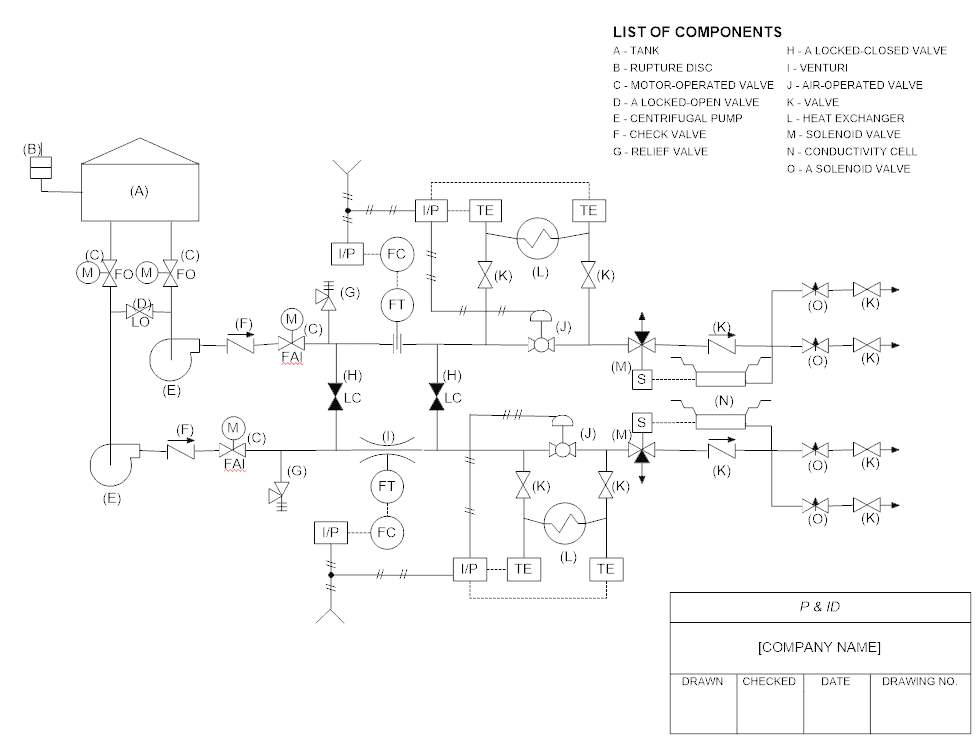6.3 Creating an Emergency Preparedness Plan
Gather the following information prior to writing up the plan.
Step 1 – Set Objectives
Objectives are goals that you and your staff intend to accomplish by following the directions provided by the emergency preparedness plan. For example, objectives for an infrastructure issue, such as a burst water pipe, would include staff and client safety, minimizing property damage, and business continuity. Business continuity is the part of the plan that identifies a way to keep operations moving forward while the emergency is being addressed. Ask how we will feed 160 people if a pipe bursts and floods the kitchen with water.
Step 2 – Identify Assumptions
Assumptions are things that are accepted as true. For example, in the case of the burst pipe, you would assume that there is a main water valve (tap) in the facility, which could be turned off to stop the flow of water into the building. Another assumption could be that your company has a licensed plumber on the payroll who could fix the pipe.
Step 3 – Identify Resources
Make a list of resources available on-site at the workplace that can be used to deal with the emergency. This could include building plans and schematics that show where the pipes and valves are in the building, first aid kits, evacuation chairs or wheelchairs. Remember to include contact information for outside resources, such as plumbers and clean-up companies.
Watch: WINMAR® Company Services
Video: “WINMAR® Company Services” by WINMAR® (Canada) International, Ltd. [1:09] is licensed under the Standard YouTube License. Music only.
Step 4 – Communication and Delegation in an Emergency Response Situation
Think about what needs to be done to manage the emergency. Think about who will do what in an emergency situation. Who will lead and delegate to others? What task will need to be completed to manage the situation? How will tasks be delegated? Who will communicate with outside resources? Does joint training between staff and community partners need to take place?
After taking time to think about and record information on the objectives, assumptions, resources and who does what in response to the emergency, it is now time to prepare the plan.
Example: Plan for a Burst Water Pipe
Activity Description
Page 1 – Introduction
This plan provides staff with information and directives on what to do in the case of a water pipe burst at the Happy Hearts Care facility. The objectives of having this plan in place are to provide a safe environment for the staff and clients, which minimizes injury and encourages safe practices first, minimize physical damage to the property, and to facilitate business continuity whenever possible.
Page 2 – Table of Contents
Contact List …………………. 1
Schematics for Building Water System………………..2
List of Action to be Taken ………………………….3
Communication Strategy ……………….4
Resources on Site…………….5
Page 3 – Contact List
Names and contact information for those who need to be reached in an emergency.
All Call Emergency Response 911
Fire, Ambulance, Police
Plumber: John Ray
Cell: 257-869-2112
Email: jray@happyhearts.ca
Public Health Inspector – Potable Water
Southwestern Public Health
Phone: 519-631-9900
Administrator, Happy Hearts
Ty Wellsome
Cell: 565-999-5484
Email: twellsome@happyhearts.ca
Maintenance Supervisor
Harshdeep Kaur
Cell: 565-999-4565
Email: hkaur@happyhearts.ca
Winmar Property Restoration Specialists
Phone: 519-451-0101
Public Relations Communications Officer
Sijing Xi
Cell: 565-999-9512
Email: sxi@happyhearts.ca
Page 4 – Schematics
Drawings that show the location of critical infrastructure.

Page 5 – Actions
Step-by-step actions for dealing with the emergency, identifying specific persons’ roles and responsibilities.
1 – Water is discovered. The cause is believed to be a burst pipe. The person that discovers the water, should immediately ask staff and clients that are present in the area to remove themselves from the area if it is safe to do so. If it is not safe to do so, the staff person should ask the other staff or clients to stay put and then contact their immediate supervisor to advise them of the situation.
If the staff person knows how to turn off the water supply, they should do so if it is safe to do so. The person who discovered the water should report the emergency situation to their immediate supervisor.
2 – The supervisor now becomes the designate in charge of the scene. The designate in charge of the scene will confirm that the water supply is turned off, the area has been cleared – there are no staff or clients in the area. If you have staff or clients in a dangerous situation, call 911 for community emergency responder assistance.
3 – The next step is to call the company plumber to request that the pipe be fixed as soon as possible. The designate will call the facilities administrator to make them aware of the issue.
4 – The designate will contact the maintenance supervisor to request clean up of the area.
The maintenance supervisor should attend the scene, assess the situation, and confirm whether or not the maintenance staff can clean up the area.
If outside resources are required for the cleanup, the maintenance supervisor will contact a property restoration company.
5 – The designate will call public health to make them aware of the situation, and request a potable water quality test be booked as soon as the situation is rectified at the facility.
6 – The designate will document the steps that have been taken in dealing with the emergency.
7 – The designate will contact the communications officer to request a meeting. The designate and the communications officer will prepare a statement for the community.
Page 6 – Communication Strategy
Steps that must be taken to effectively issue a public notification to the affected community regarding the incident.
This may include a water quality advisory, boiled water advisory, do not consume or do not use notice. The designate will share the details of the emergency with the communications officer. The communications officer will create the communication and deliver the communication to the affected community.
The designate will communicate with the Nutrition and Food Service manager regarding an alternative water supply for food production and service.
Page 7 – Resources on Site
35 cases of bottled water
6 first aid kits
10 extra wheelchairs and evacuation stretchers
Mop basin floor level sink
Wet floor signs
Personal Protective Equipment that includes N95 masks, heavy-duty rubber gloves, and Neoprene Aprons
1 x 16-Gallon Wet/Dry Shop-Vac
3 Portable Till Drum Blower Fans
Page 1 – Introduction
This plan provides staff with information and directives on what to do in the case of a water pipe burst at the Happy Hearts Care facility. The objectives of having this plan in place are to provide a safe environment for the staff and clients, which minimizes injury and encourages safe practices first, minimize physical damage to the property, and to facilitate business continuity whenever possible.
Page 2 – Table of Contents
Contact List …………………. 1
Schematics for Building Water System………………..2
List of Action to be Taken ………………………….3
Communication Strategy ……………….4
Resources on Site…………….5
Page 3 – Contact List
Names and contact information for those who need to be reached in an emergency.
All Call Emergency Response 911
Fire, Ambulance, Police
Plumber: John Ray
Cell: 257-869-2112
Email: jray@happyhearts.ca
Public Health Inspector – Potable Water
Southwestern Public Health
Phone: 519-631-9900
Administrator, Happy Hearts
Ty Wellsome
Cell: 565-999-5484
Email: twellsome@happyhearts.ca
Maintenance Supervisor
Harshdeep Kaur
Cell: 565-999-4565
Email: hkaur@happyhearts.ca
Winmar Property Restoration Specialists
Phone: 519-451-0101
Public Relations Communications Officer
Sijing Xi
Cell: 565-999-9512
Email: sxi@happyhearts.ca
Page 4 – Schematics
Drawings that show the location of critical infrastructure.

Page 5 – Actions
Step-by-step actions for dealing with the emergency, identifying specific persons’ roles and responsibilities.
1 – Water is discovered. The cause is believed to be a burst pipe.
 The person that discovers the water, should immediately ask staff and clients that are present in the area to remove themselves from the area if it is safe to do so. If it is not safe to do so, the staff person should ask the other staff or clients to stay put and then contact their immediate supervisor to advise them of the situation.
The person that discovers the water, should immediately ask staff and clients that are present in the area to remove themselves from the area if it is safe to do so. If it is not safe to do so, the staff person should ask the other staff or clients to stay put and then contact their immediate supervisor to advise them of the situation.
If the staff person knows how to turn off the water supply, they should do so if it is safe to do so. The person who discovered the water should report the emergency situation to their immediate supervisor.
 2 – The supervisor now becomes the designate in charge of the scene. The designate in charge of the scene will confirm that the water supply is turned off, the area has been cleared – there are no staff or clients in the area. If you have staff or clients in a dangerous situation, call 911 for community emergency responder assistance.
2 – The supervisor now becomes the designate in charge of the scene. The designate in charge of the scene will confirm that the water supply is turned off, the area has been cleared – there are no staff or clients in the area. If you have staff or clients in a dangerous situation, call 911 for community emergency responder assistance.
 3 – The next step is to call the company plumber to request the pipe be fixed as soon as possible.
3 – The next step is to call the company plumber to request the pipe be fixed as soon as possible.
The designate will call the facilities administrator to make them aware of the issue.
 4 – The designate will contact the maintenance supervisor to request clean up of the area.
4 – The designate will contact the maintenance supervisor to request clean up of the area.
The maintenance supervisor should attend the scene, assess the situation, and confirm whether or not the maintenance staff can clean up the area. If outside resources are required for the cleanup, the maintenance supervisor will contact a property restoration company.
 5 – The designate will call public health to make them aware of the situation, and request a potable water quality test be booked as soon as the situation is rectified at the facility.
5 – The designate will call public health to make them aware of the situation, and request a potable water quality test be booked as soon as the situation is rectified at the facility.
 6 – The designate will document the steps that have been taken in dealing with the emergency.
6 – The designate will document the steps that have been taken in dealing with the emergency.
 7 – The designate will contact the communications officer to request a meeting. The designate and the communications officer will prepare a statement for the community.
7 – The designate will contact the communications officer to request a meeting. The designate and the communications officer will prepare a statement for the community.
Page 6 – Communication Strategy
Steps that must be taken to effectively issue a public notification to the affected community regarding the incident.
This may include a water quality advisory, boiled water advisory, do not consume or do not use notice. The designate will share the details of the emergency with the communications officer. The communications officer will create the communication and deliver the communication to the affected community.
The designate will communicate with the Nutrition and Food Service manager regarding an alternative water supply for food production and service.
Page 7 – Resources on Site
35 cases of bottled water
6 first aid kits
10 extra wheelchairs and evacuation stretchers
Mop basin floor level sink
Wet floor signs
Personal Protective Equipment that includes N95 masks, heavy-duty rubber gloves, and Neoprene Aprons
1 x 16-Gallon Wet/Dry Shop-Vac
3 Portable Till Drum Blower Fans

